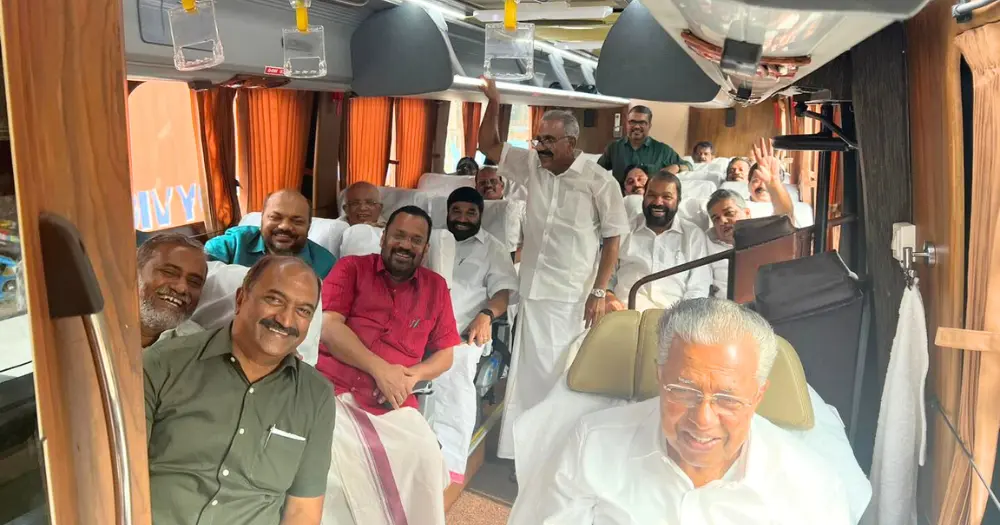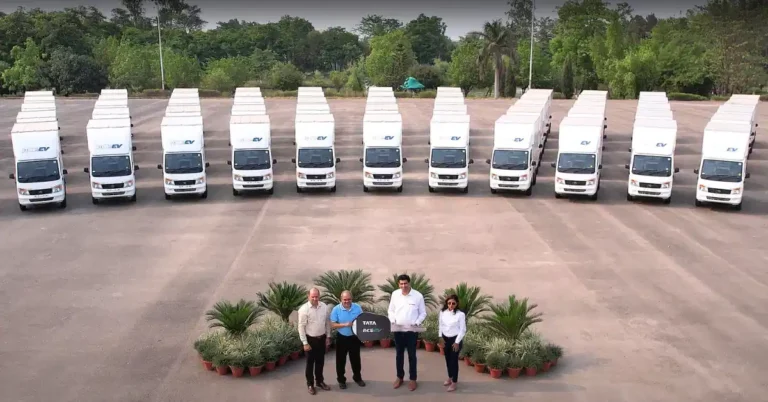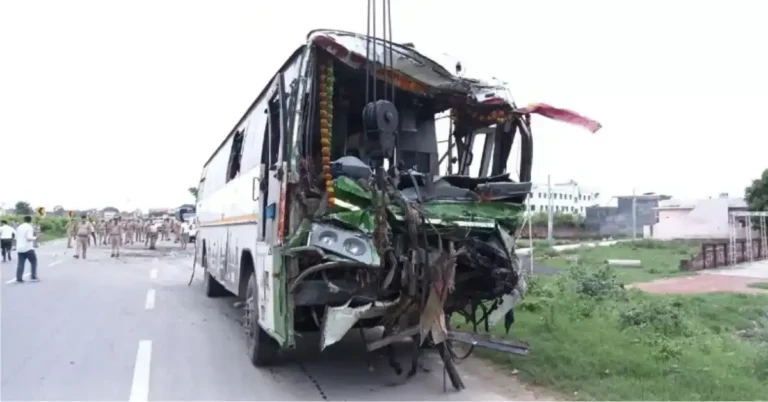KSRTC Nava Kerala Sadas Bus: Analyzing India’s Costliest Bharat Benz Bus
The 1.05 crore-worth bus, designed for the Nava Kerala Sadas program, has stirred controversy due to its high cost, sparking debates on necessity and fiscal responsibility.

In a grand spectacle, Kerala Chief Minister Pinayari Vijayan’s opulent Bharat Benz Nava Kerala Sadas Bus has completed its journey from Lal Bagh, Bangalore, to reach Kasargod today.
Over the last week, there have been immense speculations about the KSRTC‘s Bharat Benz bus for the Nava Kerala Sadas program, and as can be expected, the internet was flooded with rumors and misinformation about the bus.
The 1.05 crore-worth bus, designed for the Nava Kerala Sadas program, has stirred controversy due to its high cost, sparking debates on necessity and fiscal responsibility.
Critics, mainly the general public, argue the bus’s hefty price tag is wasteful, questioning the need for such opulence when there are existing luxury buses in Kerala KSRTC’s fleet.
On the other hand, supporters, mainly party incumbent ministers and members, argue that the bus is a necessary investment in Kerala’s tourism industry.
CPM Central Committee member AK Balan even prophecized that the bus will attain “historical significance” in the not-too-distant future, and will find a spot in the state museum.
“Once the 15-years lifespan of the bus is over, it can very well be kept in a museum. Lakhs of people will buy tickets to come and see this historic bus. It’s a very big opportunity, that we cannot miss,” he said
"മുഖ്യമന്ത്രി സഞ്ചരിച്ച നവകേരള ബസ് മ്യൂസിയത്തിൽ വെച്ചാൽ ലക്ഷക്കണക്കിന് പേർ കാണാൻ വരും"; എ കെ ബാലൻ#akbalan #navakeralabus #mbrajesh #navakeralasadas pic.twitter.com/my5HaJjZsy
— News18 Kerala (@News18Kerala) November 18, 2023
Humor aside, let’s delve into the details and assess whether the Nava Kerala Sadas Bus truly justifies its 1.05 crore price.
Why did KSRTC Invest in the Nava Kerala Sadas Bus?
The KSRTC’s costliest Bharat Benz bus was procured specifically for transporting CM Vijayan and his cabinet during the Nava Kerala Sadas outreach program.
The bus will transport CM Pinayari Vijayan and his 20 cabinet ministers, along with his Chief Secretary, the CM’s assistants, and two other assistants.
The initiative is scheduled to commence at Manjeshwaram, the northernmost constituency in the state, on Saturday, November 18th, and will culminate on December 23 in Thiruvananthapuram.
The entire council of ministers will traverse the 140 constituencies of Kerala, actively engaging with individuals from diverse backgrounds to systematically address and resolve concerns raised by the public.
Kerala is poised to make history as the #NavaKeralaSadas kicks off tomorrow at Manjeshwaram, the northernmost constituency in the state. This outreach programme, which concludes on December 23 in Thiruvananthapuram, will see the entire Council of Ministers visiting 140…
— Pinarayi Vijayan (@pinarayivijayan) November 17, 2023
You May Also Like
How will the Bus be Used After the Nava Kerala Sadas Program?

According to Transport Minister Antony Raju, who recently stirred a controversy by stating that the AITP is illegal in Kerala, the bus would later be utilized by the tourism department.
Confirming the same, Biju Prabhakar, Chief Managing Director of the KSRTC stated “The bus, equipped with various amenities, including a bio toilet, will be enlisted for ‘Budget Tourism’ services once after the Nava Kerala Sadas.”
In addition to the dedicated bus for Nava Kerala Sadas, KSRTC is acquiring two additional Benz buses.
These will cater to Budget Tourism and are available for private rental, serving purposes such as tours and marriages. One of the newly acquired buses is a luxury sleeper class, while the third is configured as a seater type.
Under the Hood: Nava Kerala Sadas Bus Specifications
Built on the robust 12-meter Bharat Benz Chassis 1624, the bus boasts a powerful BS6-compliant engine, offering 235 HP for optimal performance.
With a 6-speed manual gearbox, air brakes, and a wheelbase of 5,950 mm, it accommodates diverse body configurations, promising reliability, comfort, and efficiency.
The body of the Nava Kerala Sadas bus has been built by prominent bus body builders S.M. Kannappa, as per their Prakash Capella model.
Nava Kerala Sadas Bus Specifications
| Chassis | Bharat Benz 1624 |
| Body | Prakash Capella (S.M kannappa) |
| Length | 12 meter (Wheel base – 5,950 mm) |
| Maximum Power, kW | 180 kW @ 2200 rpm |
| Maximum Torque, Nm | 850 Nm @ 1200 -1600 rpm |
| No. of Cylinder, Displacement | 6 cylinder, 7200 CC |
| Emission Compliance | BS6, Phase 2 |
A Glimpse Inside: Interiors and Amenities

The 25-seater Nava Kerala bus features plush interiors and modern amenities akin to caravans.
Among the 25 seats, the first is a specially designed automatic reclining, 180-degree rotatable seat for the chief minister. This seat has been imported from China and took one and a half months to arrive.
Other amenities include a bio-toilet, fridge, microwave oven, dining area, washbasin, and even, reportedly, a special elevator on both doors – an intriguing addition to a seater bus.
As per reports, the VIP passengers of the bus won’t even have to ascend any steps; they simply need to approach the doors. The lift will autonomously facilitate all functions, ensuring a seamless and effortless boarding experience for passengers.
Nava Kerala Sadas Bus Livery
Painted in rich chocolate brown, the bus elegantly exhibits artistic engravings in golden color portraying Kerala’s iconic destinations, a vibrant ode to the state’s cultural richness.
Intricate designs showcase elements like fishing nets, houseboats, and diverse Kerala festivities, embodying the region’s lively spirit.
The bus’ livery also includes the Kerala Tourism’s iconic slogan tagline “God’s Own Country.”
The Nava kerala Sadas bus proudly displays the distinctive ‘KL-15’ registration number, exclusive to KSRTC. Specifically, the registration number of the bus is KL-15 A 2689.
An interesting point to be noted here is. despite regulations mandating white paint for contract carriage buses, the brown color was chosen under the special direction of the Transport Department.
Decoding the Cost: Is the Bus Overpriced?
There has been an outcry on social media that the Nava Kerala Sadas bus is extravagantly overpriced, and that it’s a misuse of taxpayers’ money.
While I am not qualified to assert if it’s a waste of tax payer’s money, I can break down the costs, and and assess whether the government has spent excessively.
The on-road price of the Bharat Benz 1624 BSVI chassis is approximately 44 lakhs. The 12-meter, 30-sleeper Capella model from S.M. Kannappa costs around 31 lakhs.
As per reports, the bio-toilet installed in the bus was imported from China for 11 lakhs.
Drawing on my experience assisting premium operators in installing bus toilets across approximately 200 buses from various body builders in India, I can affirm that of the cost a bus bio toilet should not exceed 3 to 3.5 lakhs. And that’s inclusive of plush sanitary ware and other features.
In an ideal scenario, considering 5 lakhs for the toilet, the bus’s total cost should have been around 80 lakhs.
Also, by the looks of the interiors, the bus doesn’t live up to its initial “luxurious” hype. The interiors look very plain and ordinary.
Even with an extra 10 lakhs for accessories, the maximum estimate for the Bharat Benz Nava Kerala Sadas Bus should be less than 90 lakhs, in my opinion.
It will be interesting to see what other accessories were added for the extra 15 lakhs shelled out on the bus.
Also, to be very honest, had it been built by a private bus operator with no means of access to tax payers money, he could have built the exact bus, or probably would have done a better job, in not a penny more than 75 lakhs.
How many of you agree? Let us know in the comments.
Trending Now






Caravan bus must be run by state or private operators but bus body builder must charge reasonably with lowest margin of profit so that tourism and other activities flourish. Jay Hind
W have recently covered the prices of bus body building, you can have a look at it here – Price of Ashok Leyland 13.5 meter bus.